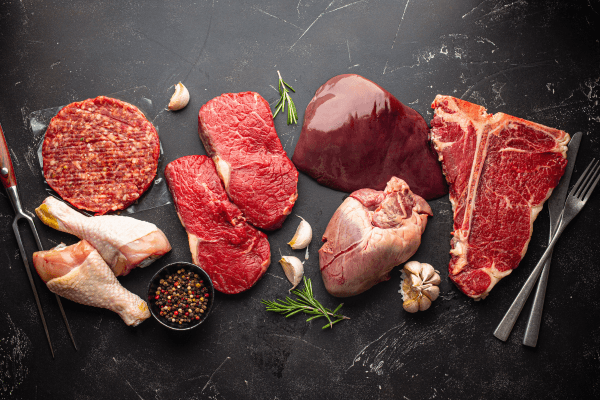What is organ meat?
Organ meat, also known as offal, refers to the organs of animals that can be cooked and consumed. In other words, offal are the edible internal parts of an animal that is raised for consumption. They are called “off-fall,” as they indicate the parts of an animal that fall far from the carcase when slaughtered. Animal liver, tongue, brain, heart etc. are commonly sold and consumed.
What are the health benefits of eating organ meat?
Organ meats are rich in micronutrients. Consuming 75-100 g of animal liver can provide you with the RDA (Recommended Dietary Allowance) of most essential micronutrients. Though the nutrition profile of organ meat will vary, here is a brief on the nutritional profile of organ meat:
- CoQ10 – They are an important source of CoQ10 (coenzyme Q10 or ubiquinone). CoQ10 plays a role in maintaining the health of all tissues and organs in our body as well as preventing free radical damage. It may also help keep mental health issues at bay.
- Vitamin A – Organ meat contains a bioavailable form of vitamin A that the body can use efficiently. Vitamin A is essential for immune function, eye health, and skin health.
- B vitamins – Organ meat such as beef tongue is a potent source of vitamin B12 and choline. These vitamins play a role in maintaining the health of the nervous system. Consuming approximately 85 grams of cooked beef tongue can provide the daily recommended dose. Organ meat also contains trace amounts of biotin, which is needed for healthy skin and hair, as well as folate, which is an essential nutrient during pregnancy for the health of the growing foetus.
- Protein – Organ meats such as liver and heart are high in protein. Approximately 100g of Beef tongue provides 19g of protein. Organ meat also provides all the essential amino acids and helps in building muscle.
- Minerals – Organ meat is rich in iron, zinc, selenium, copper etc. which are essential to prevent free radical damage, anaemia, support the immune system, promote wound healing etc.
- Other nutrients, such as vitamin C, E, and K, are present in minute quantities.
Doesn’t meat provide the same nutritional benefits as offal?
When comparing meat and its offal, the nutritional quality and biological value of organ meat is higher than that of meat.
Here is a table to understand the difference in nutritional quality of different animal meats and their organ meats:
Beef
| Nutrients | Raw beef chops (100g) | Raw beef liver (100g) |
| Energy (Kcal) | 139.82 | 119.26 |
| Protein (g) | 19.82 | 20.73 |
| Fats (g) | 6.71 | 3.96 |
| Iron (mg) | 1.95 | 14.82 |
| Zinc (mg) | 3.77 | 4.36 |
| Copper (mg) | 0.04 | 1.23 |
| Omega 3 (mg) | 66.06 | 111.51 |
| Selenium (mcg) | 11.54 | 20.2 |
| Thiamine (mg) | 0.02 | 0.17 |
| Riboflavin (mg) | 0.06 | 0.34 |
| Niacin (mg) | 4.36 | 14.01 |
| Vitamin A (mcg) | 2.43 | 9119 |
| Cholesterol (mg) | 45.97 | 261 |
Lamb
| Nutrients | Raw goat chops (100g) | Raw goat brain (100g) |
| Energy (Kcal) | 135.76 | 127.39 |
| Protein (g) | 20.39 | 13.82 |
| Fats (g) | 5.98 | 8.06 |
| Iron (mg) | 1.87 | 1.63 |
| Zinc (mg) | 4.55 | 1.08 |
| Copper (mg) | 0.07 | 0.3 |
| Omega 3 (mg) | 16.12 | 596.48 |
| Selenium (mcg) | 21.76 | 21.7 |
| Thiamine (mg) | 0.05 | 0.13 |
| Riboflavin (mg) | 0.13 | 0..17 |
| Niacin (mg) | 5.51 | 2.04 |
| Vitamin A (mcg) | 2.55 | 1.98 |
| Cholesterol (mg) | 88.37 | 1340 |
Chicken
| Nutrients | Raw chicken leg (100g) | Raw chicken gizzard (100g) |
| Energy (Kcal) | 383.6 | 92.26 |
| Protein (g) | 19.44 | 18.22 |
| Fats (g) | 12.64 | 2.07 |
| Iron (mg) | 1.27 | 3.19 |
| Zinc (mg) | 1.77 | 2.65 |
| Copper (mg) | 0.25 | 0.2 |
| Selenium (mcg) | 20.22 | 54.66 |
| Thiamine (mg) | 0.17 | 0.01 |
| Riboflavin (mg) | 0.13 | 0.11 |
| Niacin (mg) | 5.6 | 2.87 |
| Vitamin A (mcg) | 10.95 | 46.78 |
| Cholesterol (mg) | 84.25 | 57.24 |
*The nutritive value of the animal meat vs organ meat will vary on the type of cut, method of preparation and organ meat too.
Should you follow the nose-to-tail eating pattern?
Eating nose-to-tail is an age-old practice of eating which involves eating all portions of an animal for preparation of food and not wasting any portion of the animal. Eating organ meat falls under this principle too. A few benefits of eating nose-to-tail are that they help save money, reduce food wastage and most important of all they are healthier.
Why is there a stigma around eating organ meat?
Most of us may feel gross just thinking that organ meat is what is given to our pets and that it is a waste product of slaughterhouses. Though most countries still do consume organ meat commonly, it is still an unfamiliar eating habit in most regions of the world. Early civilisations considered organ meat to be food of the poor and this perception has not changed yet. But most of all the major reason for the gross factor is the belief that offal is unhealthy and unappetising.
How do you cook and eat organ meat?
1. Choose good quality organic or grass fed organ meat for high nutritional value.
2. Rinse and soak organ meat in vinegar to remove impurities and blood.
3. Never overcook organ meat as it can deplete the food of its nutrients.
4. Make sure there is no foul odour in the organ meat.
Here is a list of commonly consumed organ meat and the best method of cooking them:
| Animal/meat | Organ | Method of cooking |
| Beef | Liver | Braising, stewing |
| Tripe | Braising, simmering | |
| Tongue | Braising, simmering, boiling | |
| Oxtail | Slow and moist heat methods of cooking | |
| Calf’s liver | Sauteing | |
| Ox kidney | Long slow cooking | |
| Lamb | Heart | Oven braising |
| Sweetbread | Sauteing, pan-frying | |
| Suet | Sauteing, rendering | |
| Kidney | Grilling or pan-frying | |
| Liver | Sauteing, braising | |
| Pork | Cheek | Braising, stewing |
| Trotter | Making gravies, braising, stewing, roasting | |
| Kidney | Must be soaked in milk or buttermilk overnight | |
| Liver | Quick cooking at high heat |
Do you know these traditional British dishes made with offal?
1. Black pudding – It is a part of the traditional English breakfast. It is made from pork blood.
2. Steamed, baked and boiled puddings and pies – They are traditionally made from suet, steak and kidney.
3. Brawn – It is an English meat dish made from a pig’s head, trotters, herbs and spices.
4. Faggots – It is made from offcuts of pork and offal such as liver, lungs and heart. They are then wrapped around the membrane of internal organs and cooked.
5. Pâté – It is made from liver, pork and other meat. It is smooth or coarse in texture. It is baked in the oven and served cold with bread.
6. Haggis – This is a traditional Scottish dish which is sheep liver, lungs, heart, suet, onion, herbs and seasoning. The ingredients are then boiled in the sheep’s natural casing.
Are there any risks to eating organ meat?
Though organ meat is safe to eat, it is important to remember that consuming excess quantities of organ meat can increase cholesterol levels and also lead to heavy metal toxicity. Though organ meat does provide essential nutrients, some organs may provide more than the RDA. Be cautious of your quantity and frequency of consumption of organ meat. It is best to speak to a healthcare provider if you are unsure.
Mayuri,
Dietetic Researcher, Simplyweight





